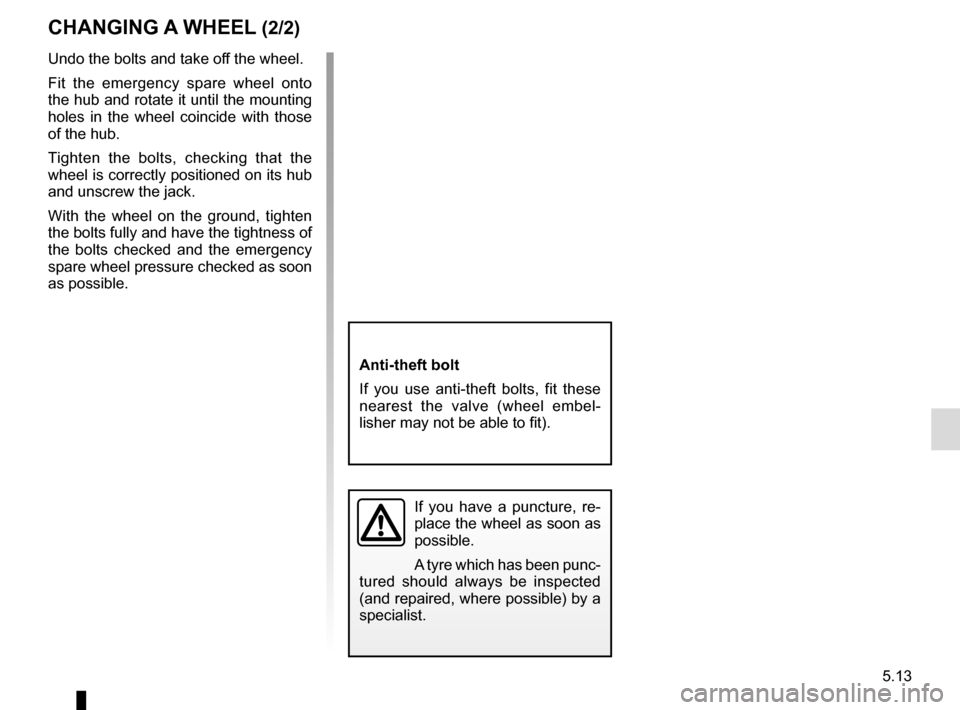2017 RENAULT SCENIC spare wheel
[x] Cancel search: spare wheelPage 295 of 358

5.9
TOOLS (1/2)
Do not leave the tools un-
secured inside the vehicle
as they may come loose
under braking. After use,
check that all the tools are correctly
clipped into the tool kit, then posi-
tion it correctly in its housing: risk of
injury.
If wheel bolts are supplied in the tool
kit, you must use these bolts, and
only these, for the emergency spare
wheel: refer to the label affixed to
the emergency spare wheel.
The jack is designed for wheel
changing purposes only. Under no
circumstances should it be used for
carrying out repairs underneath the
vehicle or to gain access to the un-
derside of the vehicle.
The presence of the tools depends on
the vehicle.
Jack 1
Fold it correctly before refitting it in its
housing (ensure that the wheelbrace is
correctly positioned 2).
Hubcap tool 3
This tool is used to remove the wheel
trims.
Screw guide 4
For tightening/loosening wheel bolts on
vehicles fitted with alloy wheels
Towing hitch 5
Refer to the information on “Towing” in
Section 5.
Wheelbrace 6
Locks or unlocks the wheel bolts and
tow eye 5.
Storage bag
This allows you to store a punctured
wheel in the boot.
1
6
3
5
2
4
Page 299 of 358

5.13
CHANGING A WHEEL (2/2)
Undo the bolts and take off the wheel.
Fit the emergency spare wheel onto
the hub and rotate it until the mounting
holes in the wheel coincide with those
of the hub.
Tighten the bolts, checking that the
wheel is correctly positioned on its hub
and unscrew the jack.
With the wheel on the ground, tighten
the bolts fully and have the tightness of
the bolts checked and the emergency
spare wheel pressure checked as soon
as possible.
Anti-theft bolt
If you use anti-theft bolts, fit these
nearest the valve (wheel embel-
lisher may not be able to fit).
If you have a puncture, re-
place the wheel as soon as
possible.
A tyre which has been punc-
tured should always be inspected
(and repaired, where possible) by a
specialist.
Page 301 of 358

5.15
TYRES (2/3)
Tyre pressures
Adhere to the tyre pressures (including
the emergency spare wheel). The tyre
pressures should be checked at least
once a month and additionally before
any long journey (refer to the label af-
fixed to the edge of the driver’s door).The pressures should be checked cold:
ignore higher pressures which may be
reached in hot weather or following a
high speed journey.
If the tyre pressures cannot be checked
when the tyres are
cold, increase the
pressures from 0.2 to 0.3 bar (or 3 PSI).
Never deflate a hot tyre.
Special note
Depending on the vehicle, there may
be an adapter which needs to be posi-
tioned on the valve before air is added. Vehicle fitted with a tyre pressure
monitoring system
In cases of under-inflation (puncture,
low pressure, etc.), warning light
lights up on the instrument panel.
Please refer to the information on the
“Tyre pressure monitoring system” in
Section 2.
Emergency spare wheel
Refer to the information on “Puncture”
and “Changing a wheel” in Section 5.
Incorrect tyre pressures
lead to abnormal tyre wear
and unusually hot running.
These are factors which
may seriously affect safety and lead
to:
– poor road holding,
– risk of bursting or tread separa- tion.
The pressure depends on the load
and the speed of use. Adjust the
pressure according to the condi-
tions of use (refer to the label affixed
to the edge of the driver’s door).
Please be aware that a
poorly tightened or miss-
ing valve cap can make the
tyres less airtight and lead
to pressure loss.
Always use valve caps identical to
those fitted originally and tighten
them fully.
Page 352 of 358

7.2
ALPHABETICAL INDEX (2/6)
deadlocking the doors ................................................ 1.5, 1.12
demistingrear screen ...........................................................3.6 → 3.8
windscreen ...........................................................3.6 → 3.8
dimensions ................................................................. 6.4 – 6.5
display ..........................................................1.66 → 1.77, 3.21
doors......................................................................1.16 → 1.18
doors/tailgate .........................................................\
..... 1.4, 1.12
driver assistance........ 2.35 → 2.39, 2.47 → 2.61, 2.64 → 2.92
driver’s position .....................................................1.62 → 1.71
driving ....... 2.2 → 2.7, 2.12 – 2.13, 2.20 → 2.29, 2.32 → 2.39,
2.67 → 2.86, 2.93 → 2.95
driving aids ...................................... 2.35 → 2.39, 2.47 → 2.92
driving position settings ...............................................................\
......... 1.28
driving recommendations ......................................2.24 → 2.29
E
ECO driving ...........................................................2.24 → 2.29
ECO mode ........................................................................\
. 2.27
electric beam height adjustment ......................... 1.100 – 1.101
electric windows ..................................................... 3.23 – 3.24
electronic parking brake ........................................2.21 → 2.23
electronic stability control: ESC .............................2.35 → 2.39
emergency active braking......................................2.40 → 2.46
emergency brake assist.........................................2.35 → 2.39
emergency braking ................................................2.35 → 2.39
emergency key ........................................................... 1.6 – 1.7
emergency spare wheel ............................................5.2 → 5.4
E
energy consumption/recovery indicator .................2.17 → 2.19
E
engine technical specifications .................................................. 6.6 engine oil ...................................................................4.4
→ 4.6
engine oil level ............................................................ 4.5 – 4.6
engine specifications ........................................................... 6.6
engine start/stop button .............................................2.5 → 2.7
environment ............................................................\
........... 2.31
ESC: electronic stability control .............................2.35 → 2.39
external temperature ......................................................... 1.90
F
fatigue detection warning........................................ 2.62 – 2.63
fatigue detector ....................................................... 2.62 – 2.63
F
faults operating faults ................................................5.38 → 5.44
filter air filter ........................................................................\
... 4.9
diesel filter ...................................................................... 4.9
oil filter ........................................................................\
... 4.9
passenger compartment filter ........................................ 4.9
fittings ...............................................................\
.....3.29 → 3.36
fixed sunroof ...................................................................... 3.25
front passenger air bag deactivation ................................. 1.59
front seat driver’s position memory .............................................. 1.27
front seat adjustment .............................................1.20 → 1.22
front seats adjustment .......................................................1.20 → 1.22
with electric controls
......................................... 1.23 – 1.24
with manual controls .................................................... 1.20
fuel advice on fuel economy ...................................2.24 → 2.29
capacity ...............................................................\
....... 1.110
consumption ....................................................2.24 → 2.29
filling ............................................................. 1.110 → 1.112
grade ............................................................ 1.110 → 1.112